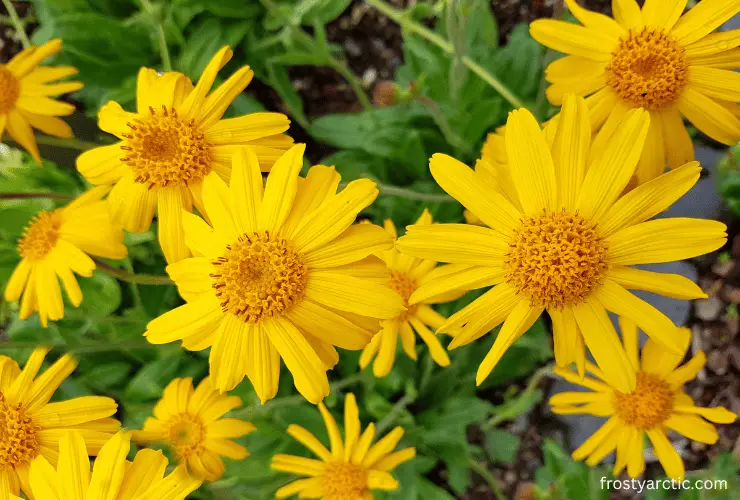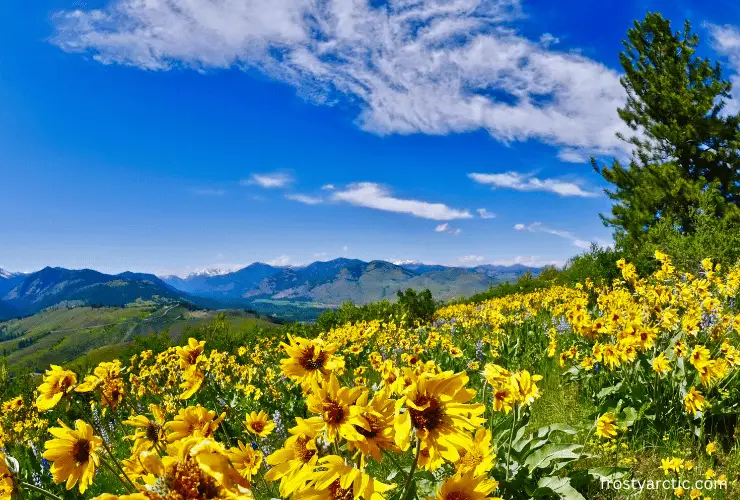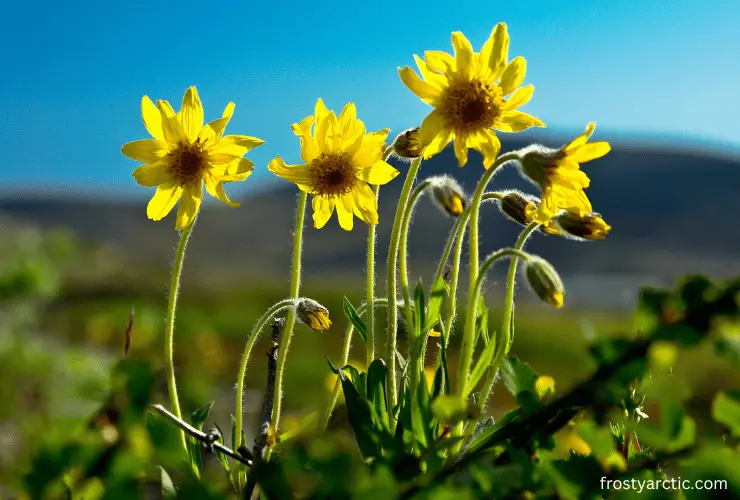Alpine Arnica is one of the perennial flowering plants that belongs to the sunflower family. This plant usually grows in cold temperatures. The yellow flower generally blooms in July to increase its beauty.
Normally, Alpine Arnica is found in many regions all over the world. In this article, I will discuss the uses, growth, and other vital information about this plant. Stay with the article till the last line.
Alpine Arnica at a glance
| Parameters | Details |
| Scientific name | Arnica Angustifolia |
| Plant type | Perennial |
| Plant size | 10-40 cm |
| Leaf size | 7-23 inches |
| Width | 1-2 feet |
| Soil condition | Alkaline, sandy |
| Watering | Normal |
| Sun exposure | Full, semi-shade, shade |
| Leaf color | Green |
| Blooming color | Yellow |
| Toxicity | Yes, toxic and poisonous |
| Blooming season | July to August |
| Uses | Medicinal, tea |
What is an Alpine Arnica?
Generally, Alpine Arnica is one of the perennial, herbaceous flowering plants. The scientific name of Alpine Arnica is Arnica Angustifolia.
This flowering plant belongs to the sunflower family known as Asteraceae. It usually has unbranched stems, and the root of the plant is deep. That’s why it doesn’t need that much water like other plants.
Usually, you can grow them in slightly alkaline and sandy soil as it is the best for the growth of Alpine arnica plants. This plant doesn’t have long size, and the stems are densely haired at the top.
Also, during the blooming season, you will get beautiful yellow flowers. Normally, the plant can grow up to 10-40 cm long. Flowers are 1.4-2 inches in broad. Leaves appear on the stem as a pair. For this reason, many gardeners plant this flowering herb as garden accessories.
Why is it called Alpine Arnica?
This plant can grow in the alpine climate, in the high mountains, and above the line where trees grow. It is the reason behind the term “Alpine.”
On the other hand, the origin of the term “Arnica” is still uncertain. But a strong piece of information is that the name came from the Greek word “arnakis.”

Arrakis refers to fuzzy and soft hairs appearing on the plant’s stems. By combining the information, this flowering plant is called Alpine Arnica.
Where does Alpine Arnicas grow? Arnica Growing Conditions
Alpine Arnica usually grows in Asia, Europe, Northern and Western America, Alaska, and Canada. Also, it can thrive in the Rocky Mountains on the north side.
Alpine arnica prefers cool temperatures and poor and well-drained soil. Do you know that the root of this plant goes deep into the ground?
That’s why it can even grow well in rocky ground, as its roots can collect adequate water from the deep ground.
You have to ensure that there is no standing water where you plant this herb. The reason is that if the soil isn’t well drained, the plant’s roots will rot shortly.
Besides, it likes to thrive in alkaline soil. That is why they can grow well even on calciferous rocky ground. It can grow above the tree level, where most plants can’t grow.
How do you identify Alpine Arnica? [Appearance]
The physical characteristics make it different from other plants. You can identify easily if you know the physical characteristics of this plant. Here I am mentioning several physical characteristics of this plant:
- Height: The height of Alpine Arnica is not long. It can usually grow 10 cm. But the highest height it can get is 40 cm.
- Flowers: Flowers divide into two parts. A single part, like the capitula and the involucral bracts, surrounds this capitula flower. The whole flower is (1.4-2) inches broad. You may find the capitulum flowers of yellow color. Generally, they are ray florets and tongue-like. Involucral bracts are spread in 2 same-length rows.
- Leaves: Leaves appear in stems and basal rosettes with pairs. The pairs may be 1 or 2 in number. They seem opposite to each other. If you notice carefully, you will find that leaves are almost parallel-veined.
Alpine Arnicas Adaptations
Alpine Arnica is self-incompatible. It is difficult to conserve and restore tiny, isolated populations. The reason is you may find acceptable donor populations to provide genetically deficient populations with compatible and well-adapted genotypes.
- Short length: The length of the Alpine arnica is not bigger than 2 inches. The small size gives advantages to the plant. It protects the plants from the harsh wind. Moreover, in winter, a snowpack protects the plants.
- Evergreen foliage: This also helps the alpine arnica plants during the season of growing. These leaves can start photosynthesis even if the temperature rises above freezing temperature.
- Fuzzy leaves: The great advantage of having fuzzy leaves is that this kind of leaves can help to retain moisture. As a result, the transpiration rate becomes reduced. The moisture present in the clouds is combined with Alpine Arnica leaves.
- Rosette form: Rosette forming has a significant advantage in adaptations of the alpine arnica. Besides, it helps plants with temperature adjustment.
- Rhizomes: The rhizomes of this plant store carbohydrates for providing nutrients to the plant in winter. Also, it has a vital role in reproduction and fast spreading.
How Much Sun Does Alpine Arnicas Need?
Full sunlight is the best for Alpine arnica. But they can grow under freezing temperatures, also.
But in extremely hot weather, full sunlight might not be that much of a blessing for the alpine arnicas. In this case, Alpine arnica gets some benefits from shaded sunlight.
They have green leaves that do the photosynthesis process to produce food. And the leaves can immediately run the process if the temperature rises above freezing.
How Does Alpine Arnica Reproduce?
Alpine Arnica can reproduce in two ways. One is the sexual reproduction method, while the other is the vegetative reproduction method.
In the sexual reproduction method, the seeds of a plant spread around with wind and are carried to another plant. Besides, pollinators also assist in the process of this reproduction.

Alpine Arnica draws different types of insects like bees, moths, and butterflies because it benefits the pollination process.
These plants generate more seeds at the close of the summer and the start of the fall. These seeds can now be carried out by pollinators or the wind.
They can also reproduce themselves from rhizomes. This process is known as vegetative reproduction or asexual reproduction of the alpine arnica. In this process, during the horizontal expansion, rhizomes sprout new shoots from their nodes or budding points. With this, roots also keep growing from the bottom portion of the rhizomes.
Is Alpine Arnicas Edible?
Usually, Alpine arnica isn’t edible. These plants are rarely used as an internal herbal remedy because of some disadvantages. It can cause some problems like dizziness and heart irregularities.
Moreover, Alpine arnica can irritate mucous membranes also. When the alpine arnica plant goes inside the body, you may feel nauseous, and sometimes you may vomit.
The actual herb of the plant is toxic. It can cause severe problems to your liver, and this can be fatal. Even if you want to take it in the mouth, never try it in concentrated form. I will highly recommend diluting it before taking it.
Alpine Arnica Taste
People take the flowers and roots of alpine arnica as a homeopathic herb. Now, both the flowers and roots of this plant have a bitter taste.
Generally, Alpine arnica plants are poisonous to internal organs. It can damage your heart and cause bleeding also. Thus, do not taste any Alpine arnica flower or stems or roots without consulting with a doctor.
Alpine Arnicas Uses
Alpine Arnicas have widespread uses, most of which are for medical purposes. Here are a few uses of this plant:
- This plant can help with some diseases as well as injuries
- Used for reducing swelling
- Some injury makes the skin discolored. Alpine arnica can help to reduce discoloration.
- Work against osteoarthritis
- Muscle pain can be treated.
Alpine arnica has many other uses that the doctor can’t examine to see whether it works.
What Animals Eat Alpine Arnica?
Many animals can eat Alpine arnica, and all of those animals eat this plant for medical purposes. But, also, Excess amounts of arnica can be poisonous for pets.
You can use homeopathic Alpine arnica for animals. But you need to dilute the homeopathy arnica for safe consumption. One small dose for animals has excellent benefits.

As this plant grows at high places in Rocky Mountains, most of the animals can’t reach those places. That’s why this plant doesn’t have that many predators. Still, you can feed this plant to most pet-like animals. Some of those pet animals for who this plant is suitable are:
- Dogs
- Cats
- Horses
- Ships
- Goats
- Alpine Caribou, and reindeer
What Did Native Americans Use Alpine Arnicas For?
The tremendous medical use of alpine arnica began hundreds of years ago. The native Americans used the root of arnica mainly.
- Tea: They used it to make tea using the roots. This tea was beneficial to them to help with back pain.
- Tobacco: Native Americans used to use dried roots or leaves as tobacco. That’s why this plant is also known as mountain tobacco from ancient times.
- Massaging Oil: They used to use the petals of the flowers of this plant for pain relief purposes. Mainly they used to mix it with oil and rub it on the muscle to reduce the aches.
- Skincare: Native Americans also used this plant as a skin care product. Mainly, they were used to apply it as a gel on their face to prevent rashes.
- Anti-infection: Reducing the infection and preventing swelling was one of the best uses of the plant by Native Americans.
Is Alpine Arnicas a Medicinal Plant? Medicinal Use of Alpine Arnica
Yes, it is a medicinal plant. This plant is famous all over the world for its medicinal performance. Medicinal use has begun since 1500. Here are some medicinal benefits of Alpine Arnica:
1. Stomach Pain
Alpine arnica is famous for making medicinal tea. This tea is very helpful in reducing gastrointestinal disturbances. As a result, it will solve your indigestion troubles. Also, this will be very beneficial in reducing your stomach pain.
2. Pain management
This plant contains sesquiterpene lactones, phenolic acids, and flavonoids. Each of these components has a significant effect in reducing pain.
3. Reduce inflammation
Alpine arnica has anti-inflammatory properties, which help reduce inflammation of insect bites and any kind of swelling. This plant contains helenalin, which blocks the activity of several enzymes responsible for inflammation.
4. Osteoarthritis treatment
This is a disease of wearing of the cartilage that protects the bone joints. Doctors use Arnica alpine gel for osteoarthritis treatment. This gel can work almost similarly to ibuprofen to keep the joints well-functioning.
5. Homeopathic preparation
Arnica plants have been used for homeopathy medicine for a long time. The dilute arnica is not poisonous to the internal body. It can help with some injuries like sore muscles and bruises.
6. Wound Healing
This plant has an excellent effect on the wound-healing process. The Anti-infection, anti-inflammatory, and anti-parasitic ingredients of alpine arnica help to recover the trauma of muscle and skin. Even in some places, doctors also use this plant in burn treatment.
FAQs
When to plant arnica?
The best time to plant arnica is the end of the summer and the beginning of the fall, as the flowering time is July-august. In the late summer, the soil is prepared for seeds.
Does arnica grow in Canada?
Yes, arnica grows in Canada as they are generally Canadian flowering plants. This plant is most familiar in Quebec and Newfoundland Island. You will find five subpopulations of arnica in Quebec and three in Newfoundland.
How long do Alpine Arnicas grow?
Generally, they can grow up to an average of 20 cm. But it can rise to the highest length of 40 cm. How long they will grow depends on their growing conditions like temperature, sun exposure, watering, and soil quality.
Conclusion
Alpine Arnica is one of the most famous medicinal plants in the world. For thousands of years, this plant has been used for diseases and injuries for humans as well as animals.
Avoid touching the plant with your mouth. Otherwise, it can cause fatal issues with your health. After all, this flowering plant can increase the beauty of your garden with its color combination.


